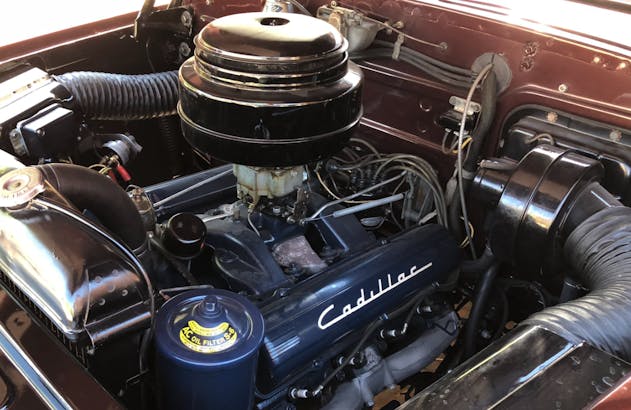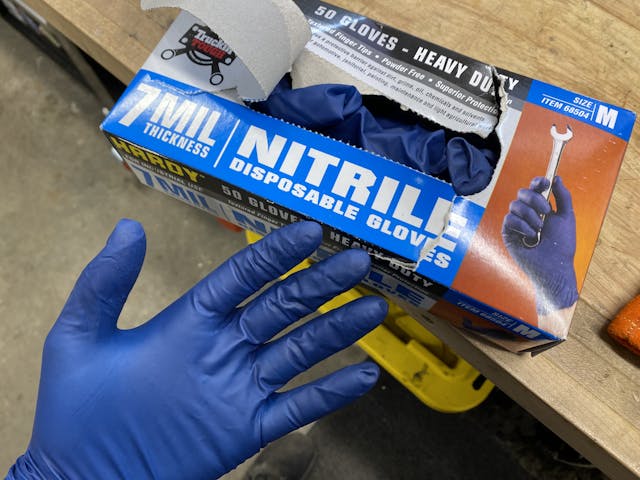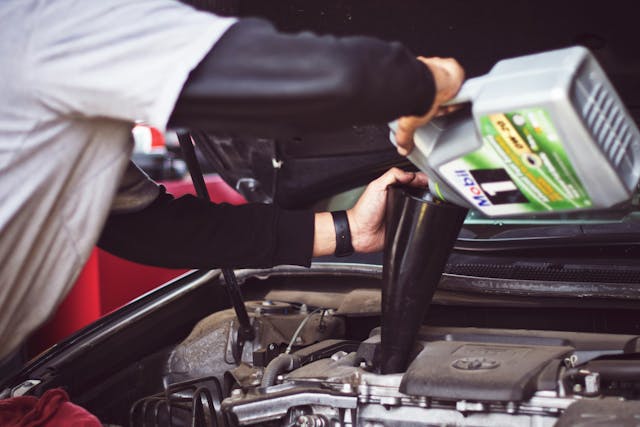8 oil change dos and don’ts
It’s a small job that somehow became a rite of passage for gearheads: Oil changes. The draining and refilling of engine oil is the first task that many budding wrench-turners undertake, and its certainly an important one. Like any other task in the automotive world, there are some pieces of institutional knowledge that comprise the key dos and don’ts for a smooth oil change. So let’s put these lessons learned out in the open, with the mission of shortening the process for newbies. And perhaps to reinforce some best practices for you veteran mechanics?
Don’t go crazy with warm-up

Modern oils are pretty amazing at suspending particles and contaminants, but there is still some junk that sinks down to the bottom of the pan. It needs to be stirred up to ensure it escapes when you pull the drain plug. Starting the engine and letting it idle for a minute or two is perfect for that final circulation. Run it any longer and you’re rewarded with nothing more than scalding hot oil that does nothing more than burn you. Before you pull that (drain) plug, give the engine a minute after shutting down, allowing the oil to drain to the pan from the nooks and crannies higher in the engine. But before you get underneath the vehicle to do the deed, remember you must…
Wear disposable gloves

Nitrile gloves keep you from soaking up solvents and oils into your skin. I’ve found 7mil thick to be a nice sweet spot of durable and affordable.
We all know the guy at the auto parts counter who has seriously gnarly hands from all the years being soaked in oil over decades of engine builds. That’s the visible damage. The invisible damage is sitting in your internal organs. All the hydrocarbons that get absorbed through the skin and are processed in our gut where they can’t be broken down. They end up accumulating in our body, which can cause serious health complications after years and years of chemical exposure. Preventing those issues is easy as putting on a pair of nitrile gloves. Use them even if it’s only for pulling the filter and drain plug, which you can do efficiently with…
The drain plug trick

It’s not groundbreaking, but nothing feels better than the perfect pull on a drain plug to ensure you don’t get any oil on your hand. The trick is pressure, not pulling. As you unthread the plug by hand, push in–against the bolt as in comes out–so the threads act as a seal with the outer edge. With a little practice you can get the pressure right (while not rocking the plug in the threads) and can spin the plug a full turn to feel for the “click.” That click means the bolt overlapped the last thread. With a swift motion away from the direction of oil flow, remove that now-loose plug. Presto! This can make thin viscosity oil changes much cleaner, and thick stuff like 20-50 can sometimes be spotless. In your excitement of not having a mess to clean up after draining, make sure you…
Don’t over tighten the drain plug or filter

It’s come to the point where stuck filters and stripped drain plugs are no longer a joke. Neither the filter nor plug require any real torque when installed properly. Use a small amount of oil to lube the filter’s rubber seal, then spin it into place. After the gasket seats on the housing, turn it only about three-quarter of an additional turn. Some applications might call for a full turn, but that is usually reserved for heavy duty equipment. Any tighter than what the filter manufacturers call for and you run the risk of deforming that rubber seal, which could cause oil to leak past the seal. That’s bad news. Any oil spillage is bad, so when you are filling…
Just use a funnel

The oil fill port on most engines is in that perfect spot where it looks like you could pour directly into it, except that’s a lie. They seem to be ideally located, but cleaning up if you miss (by even the smallest margin) can be a major pain. Are we really going to work so hard to spot and address leaks, to keep our engines clean, and just ruin it while doing routine maintenance?
I’m not. A funnel all but guarantees I won’t have to do any clean up after filling, even if I’m distracted or letting my 7 year-old niece do the filling. Putting in that fresh oil feels good, but be careful and…
Don’t overfill

This shows the rotating assembly without the oil pan and it’s easy to tell how oil at too high of a level would be bad.
Too much oil is just as bad as not enough. Seriously. The oil level in a wet-sump engine is carefully calculated to keep the rotating assembly from whipping through the oil. That action causes foaming, and oil foam pushed through the oiling system is the same as not having oil at all. I don’t need to tell you how bad that can be, so check the service or owners manual for the proper fill level. When done, look at the dipstick as a double check. Luckily, the empty oil containers you now have at this point are are perfect to…
Recycle your used oil

It’s never been easier to properly recycle used oil, so there is no excuse to do otherwise. Just about any auto parts store takes it, so they should be your first trip in your freshly serviced vehicle to “return” your oil. Be sure to capture oil in a non-contaminated pan so that the oil can actually be recycled. Coolant is the main enemy here, so be sure to flush your drain pan before the oil change. Luckily you don’t have to worry about how dusty or dirty the pan is, but other fluids can defeat the purpose of recycling. But before you make the trip to recycle the oil, be sure to…
Reset the computer (or write down your service date)

Modern cars have an oil life monitoring system. Whether you trust it is a personal preference, but for the sake of eliminating confusion, go ahead and reset it now. Most reset procedures involves cycling the ignition key and pressing the throttle pedal a certain number of times. The service manual will outline it, or a quick search to an online make/model specific forum will have the instructions. If your vehicles are of the manual variety, write down the oil change date in a log book. Or consider service tracker kept in the car or garage, as it keeps you from forgetting what’s been done. Not to mention thisa paper trail shows good stewardship to a potential next owner, which can mean an easier sale for more money.
In all, oil changes can be simple and rewarding for newbies and DIY enthusiasts alike. Following these best practices will not only keep your vehicle happy, but also make the experience better for you each time. Do you have something specific you add to this process? Let us know about it in the comments below.
***
Check out the Hagerty Media homepage so you don’t miss a single story, or better yet, bookmark it. To get our best stories delivered right to your inbox, subscribe to our newsletters.



I would pull the coil wire and crank the engine until I saw oil pressure and then reconnect and start the engine.
In most FI cars, holding the accelerator to the floor while cranking shuts off the fuel injectors.
I hate the gloves and the sweaty hands I get but I’d rather wear them than be soaked in oil.
Here’s an oil change tip I learned from experience when I was about 18. Be sure to put the drain plug back in the oil pan before you pour in the new oil. I was very sad when I pulled the oil catch pan out from under the car and realized it contained ten quarts, five quarts of used oil and the five quarts I had just poured into the engine.
3000 miles, 7000 miles, 10000 miles what about looking a little deeper into factors that should be considered when changing oil. All you hot goddess, muscle car owners, blown and turbo guys n gals. Have you ever smelled you oil after 300 miles? Yeah smell the engine oil and notice how much it is beginning to smell like gasoline! Those engines are undoubtedly running marginally richer than the average passenger car. For that reason more fuel is being flushed past the rings and into the oil pan. Now you 20/50 Valvoline is getting closer to kerosene than you want to think about. If you got mega bucks invested in your stout power plant an oil change every one thousand miles might be considered real cheap insurance.
Write the drain plug size on the radiator support or underside of the hood ( especially if you own more than one vehicle) how many times have you had to climb out from under the car because you started with the wrong size wrench 🔧
I have collector cars which rarely are driven more than a 1000miles/ year…..I always change the oil and filter annually…..is it necessary?……some “Oil expert” claims you should change in the Fall as all the combustion contaminates will float up into the engine compartment and cause damage over the Winter……any thoughts?
I use a lift with a height adjustable oil catch pan ,remove the plug, while the oil is draining, remove the filter (can be messy), check the manual transmission and differential lub. levels, grease the suspension,and check the tire pressure including the spare…after “replacing the plug”and filter ,I lower the car, fill it with oil and ZPPD additive as all my old cars have flat tappet motors ,check the oil level on the drip stick, start the engine, watch for the oil pressure to come up and check for leaks,esp. around the filter. Check the automatic transmission level when the engine has warmed up……every manufacture has a different technique for that process.
I have a 69 Series 2 XKE. The thing leaks so much oil that chages are hardly necessary. The garage floor under where I park my Porsche is spotless. I could go into the petroleum recycle business with all the oil under where I park the Jag, And that’s despite the the oil drainpan I keep under the car!
I have eye problems, I read the 1st 2 pages, my eyes are killing me at the moment! I’ll read the rest tomorrow? I didn’t see any mention of oil filters? Stay away from FRAM, buy the Best you can, check filters out on Google! Use FULL SYNTHETIC, NO Blends, read the label??? Happy New Year, stay safe, Boston Jim
I would agree with all the recommendations, except the one about waiting a minute post-shutdown, to pull the plug. I believe the best time to pull the plug is IMMEDIATELY after shutdown, when the most contaminants are suspended in the oil. To allow the oil from the upper parts of the engine to drain out, I try to allow the engine to drain for at least a half-hour, before putting the drain plug back in.
I have never worn gloves in almost 50 years of changing oil, and am not going to start now. I could see that would be a very important thing to do for someone who does oil changes professionally, though.
I would point out that while most drivers change the oil based upon mileage, some may require based upon engine hours. (If is so equipped) Especially for those people that may idle more than normal. (such as a pursuit car on a second life)
Did I miss the part to be sure you fill the filter with oil as well? That is still protocol isn’t it?
In the early ’70’s a neighbor helping me with my ’50 Dodge put about a cup of diesel fuel in the oil fill and then let the car run for a couple of minutes. He claimed it helped to get dirt out before changing the oil. I still do it.
Sorry if this has been offered already. Just to be sure I know when I did this, I scratch the date into the bottom of the filter. Don’t write with anything as the heat will probably fry it off.
Note that there’s a special valve available to replace the plug though it’s expensive and just hangs out there in the wind wafting for something to peel it off…NO thanks. 😛
Minimum half dozen of my old coworkers – Municiple Bus Operators had their engines seize or prematurely died because they didn’t change or check oil . this in the 90’s so they were driving 80’s – 90’s veh’s. but not limited to 2010’s & beyond w/similar stories. you figured they will know better being a commercial driver.
myself old school change every 3000 k w/conventional & never had issues w/ over dozen cars lasting 200,000k + or 5-7k w/ syn but not 10,000 my 2 cent’s sense.
It’s a good idea to run the engine after the oil/filter change to check for leaks.